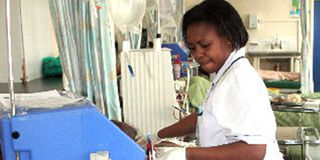MES dialysis kits offer respite as cases surge

A nurse attends to a patient at a renal unit.
The number of patients accessing dialysis services in public hospitals has shot up dramatically, data from the Ministry of Health has revealed.
From 700 sessions a month in 2015 to over 400,000 sessions over the same period in 2020, all the 54 renal units countrywide have registered growing demand.
In 2015, there were only six renal units. This has since grown to 54, but experts say they are still overwhelmed.
Numbers started growing in 2016 following the introduction of the Sh2.3 billion kidney dialysis project funded by the government under the Managed Equipment Services (MES) initiative.
In 2016, the country conducted 18,218 sessions per month, an increase of 100 percent from 2015. This shot up to 30,155 sessions in 2017 and 60,100 in 2018. In 2019, there were106,900 sessions.
Last year, the country registered the highest number of sessions conducted in a month (128, 200).
From spending Sh20,000 to Sh35,000 a month on dialysis at the Jaramogi Oginga Odinga Teaching and Referral Hospital in 2010, Rodgers Otieno now has a reason to smile.
“When I was diagonised with kidney failure in 2010 and placed on dialysis, I would travel every week to Kisumu, 70 kilometres away, for dialysis,” says Rodgers who hails from Gem Akala in Siaya County.
However, since 2015 when the government installed a renal unit at the Siaya County Referral Hospital, Rodgers is one of the 15 patients who feel some relief.
Dialysis programme
Although the MES scheme, started in 2015, has come up for various criticism — from the way it was contracted to the value-for-money proposition for a lot of the equipment — the dialysis programme is the gold standard in that project, eventually providing 360 state-of-the-art dialysis machines to all 47 counties.
Kenyatta National Hospital had the highest number of dialysis sessions (60,000) followed by Moi Teaching and Referral Hospital (46,200 ), and Nakuru Level Six Hospital (28,257).
The Coast General Teaching and Referral Hospital had the fourth-highest sessions at 14, 599 while Machakos Level Five Hospital came fifth at 13, 564 sessions.
The health facilities with the least number of sessions were Nyamache Sub-county Hospital with only 669 sessions, Hola County Hospital (682), Lodwar Hospital (756), Maralal County Hospital (1,346) and Lamu County Hospital (1,591).
About 1,458 kidney patients are currently registered for dialysis countrywide, with Moi Teaching and Referral Hospital leading with 172 patients followed by Kenyatta National Hospital (166), Nakuru Level Six Hospital (89), Kenyatta University Teaching, Referral and Research Hospital (72), Machakos Level Five Hospital (54) and Murang’a County Referral Hospital (59 ).
Chronic kidney disease is a growing cause of death and disability. A large number of the cases progress to end-stage failure unnoticed. It is estimated that about four million people, or 10 percent of the population, are likely to develop kidney diseases in their lifetime.
Electrolytes
Dialysis purifies a patient’s blood using a machine. It helps keep body fluids and electrolytes balanced when kidneys no longer function properly.
The procedure balances body fluids by removing waste, extra water and salt and ensuring they do not build up to dangerous levels.
Nairobi County had the highest number of dialysis sessions in the last half of 2018.
In Kakamega, the county’s general hospital has reported an increase in patients seeking dialysis services in the last two weeks. The hospital has nine machines and can serve 18 patients per day. It has conducted 8,937 sessions for 39 patients.
In Nyanza, the renal unit at the Nyamira County Referral Hospital has eight machines that conduct at least 40 dialysis sessions per week. It has conducted 8,078 sessions. Kisii Teaching and Referral Hospital’s renal unit conducts close to 80 sessions per month with its 10 machines while Kisumu’s Jaramogi Odinga Oginga Teaching and Referral Hospital has conducted 9,800 sessions, about 200 per month.
The seven-year project (2015-2022) involved building and equipping the renal units with each getting five dialysis machines, two dialysis beds, one reverse osmosis plant, and various furniture. Some of the counties have since gotten an extra machine on request to deal with the high numbers.
“If there is one project that has impacted Kenyans lives, this is it. We can vouch for it,” a Ministry of Health official told Sunday Nation, adding that it is the only fully operational component of the MES project.
On challenges, the official said some of the counties were experiencing water shortages and stock-outs of consumables but most machines are operational.
Kidney disease
The story of Kenya’s kidney disease management is fraught with missteps and utter criminal neglect. For one, between 1963 and 1978, the country had only one dialysis machine at KNH.
Between 2002 and 2013, four regional centres were set up in Nairobi, Kisumu, Nakuru and Mombasa. But these could not serve the tens of thousands of Kenyans who needed dialysis. Long queues and desperate faces were common in the waiting bays.
On average, a single dialysis session costs between Sh9,500 and Sh16,000. Patients spend between Sh20,000 and Sh40,000 every week for two sessions, when one factors in transport and accommodation costs.
But, thanks to the National Health Insurance Fund (NHIF), patients do not pay a single cent to access the services unless they exceed the required sessions per week. NHIF has restricted the sessions to 10 a month, with an extra session requiring pre-authorisation.
According to NHIF, dialysis is its single-largest medical insurance claim, with the payouts for treatment of kidney failure increasing by 41 percent in 2019 and the agency releasing Sh1.8 billion.
This was an increase of Sh1.24 billion in the 2016/17 financial year, highlighting the cost burden of the procedure to insurance companies.
In the last half of 2018, NHIF paid a further Sh64.7 million towards kidney transplants, up from Sh21.7 million in 2017.
This makes the procedure one of the top expenditure items in the healthcare benefit package.
NHIF paid Sh922.8 million for 73,757 dialysis sessions countrywide.





